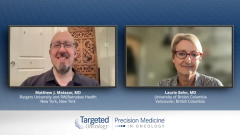
Multiply Relapsed Follicular Lymphoma: Overview on CAR T-Cell Therapy
Shared insight on the development and use of CAR T-cell therapy in patients with multiply relapsed follicular lymphoma.
Episodes in this series

Transcript:
Matthew J. Matasar, MD: I guess the opposite end of the spectrum from tazemetostat with modest activity but extraordinary tolerability would be CAR [chimeric antigen receptor] T-cell therapy, which is a treatment with a well-characterized and significant toxicity profile with tremendous activity, even in patients with multiple relapses and at high risk for follicular lymphoma. What’s your current approach to CAR T-cell therapy? In which patients is this a preferred treatment approach, in your opinion?
Laurie Sehn, MD: I think it’s not a surprise to any of us that a disease like follicular lymphoma would be amenable to treatment with an immunotherapy approach such as CAR T-cell therapy. The data is probably not surprising to anybody that this is a modality of treatment that may be valuable for this indolent lymphoma, where we know that immunotherapy can be very powerful. The problem with CAR T-cell therapy, in my mind, is that it is still more of a big-gun treatment. It’s cellular therapy, but we know that it comes with real potential toxicities for patients, both in terms of acute risks such as neurologic toxicity and cytokine release syndrome, and delayed toxicities with prolonged cytopenias. With a disease that is a marathon and requires treating patients over the course of their lifetimes, at what point do you bring in CAR T-cell therapy? The answer is a little unclear.
It’s also a capitated resource in many places. It’s a growing field of importance for lymphoma, certainly. In my own clinic...we have limited access to CAR T-cell therapy for follicular lymphoma because we’re still trying to grapple with the resources, needing to provide it for all patients with more aggressive lymphomas that were shown to be potentially curative. I would say that currently, the data obviously supports CAR T-cell therapy being a potentially valuable treatment option for patients with follicular lymphoma in the third-line setting or beyond. But not all patients are equal in the relapsed/refractory setting. We’ve got many patients who have delayed relapses—their last treatment was 7 years ago, and they need to go on to the next treatment. Just because there’s a third line, it doesn’t mean I’m out of options. We reuse therapies all the time in patients with follicular lymphoma.
With all my patients, I ask myself, what have they received already? How have they benefited from what they’ve received? How long have they benefited? How did they tolerate it? And then [I review] all the options I have, and certainly reusing options that have been used before can be a consideration. How does that weigh against CAR T-cell therapy, resource intensity, and the expense? But a more concerning consideration would be, is this going to close the door down the road for any other treatments for these patients? If a patient develops prolonged cytopenias from CAR T-cell therapy can I come in with another drug down the road? I might now be prohibited from giving it. So I think tThere are some concerns around CAR T-cell therapy regarding its expense and toxicities where I probably would have look at a patient to [determine where I’ll] need to bring in this modality vs use some of the other options that might be less intensive, and save CAR T-cell therapy for further down the line.
I’d really love to hear what you have to say in terms of what you do in your own clinic because the data is still very early regarding the use of CAR T-cell therapy for follicular lymphoma. Despite the extended course of the disease, we still have only short-term follow-up. With longer follow-up, if we find that we’re able to cure some of our patients with follicular lymphoma, I think CAR T-cell therapy is a total game changer. But right now, it’s just another therapy that has the capacity to control the disease for a period of time. Thus it entails a risk-benefit vs an expense-resource balance.
Matthew J. Matasar, MD: I completely agree. The data are attractive; it’s clearly potent. But it’s the minority of patients who require that big gun. Patients who have transformed disease, patients in a highly aggressive fashion, those who have a loss of CD20, rapidly progressive disease, highly refractory disease, patients who need a very quick response or else are at risk of dying from disease, those are the patients who are preferentially shunted toward CAR T-cell therapy. But for me, the broader opportunity of CAR T-cell therapy is the proof of principle. It’s not surprising that follicular lymphoma should respond to T-cell therapies, but I really view it as a proof of principle, and it makes investigations into other immunotherapeutic approaches of follicular lymphoma more attractive.
Transcript edited for clarity.










































